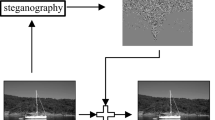Abstract
The steganalysis method based on Convolutional Neural Network (CNN) has attracted wide attention in the field of steganalysis. This method typically uses high-pass or derivative filters to pre-process images. Multiple filters can be used to improve the detection accuracy. However, the use of multiple filters may generate redundant residual images and redundant features. Redundant features not only consume computing resources and time but also cause model over-fitting, thus compromising the detection accuracy of the model. Therefore, we proposed a filter subset selection method to develop a well-designed pre-processing layer for CNN-based steganalysis framework. This method discarded many high-pass and derivative filters according to the mechanism of convolution operation and the correlations between pixels. Structural Similarity (SSIM) was used to calculate the similarity between the filtered residual images and arrange them in ascending order. Finally, based on the arranged filters, a series of experiments were conducted to determine the optimal filter subset and the optimal CNN-based steganalysis framework. The experimental results indicate that the proposed method not only guarantees detection accuracy but also improves the training efficiency of the model. Therefore, this method offers an optimized trade-off between computational complexity and detection accuracy.









Similar content being viewed by others
Explore related subjects
Discover the latest articles and news from researchers in related subjects, suggested using machine learning.References
Dong J, Qian Y, Wang W (2017) Recent advances in image Steganalysis. Journal of Image and Signal Processing 6(3):131–138
Feng G, Zhang X, Ren Y (2019) Diversity-based Cascade filters for JPEG Steganalysis. IEEE Transactions on Circuits Systems for Video Technology
Filler T, Fridrich J (2010) Gibbs construction in steganography. IEEE Transactions on Information Forensics 5(4):705–720
Fridrich J, Kodovsky J (2012) Rich models for Steganalysis of digital images. IEEE Transactions on Information Forensics and Security 7(3):868–882
Goljan M, Fridrich J, Cogranne R (2015) Rich model for Steganalysis of color images. IEEE International Workshop on Information Forensics & Security
Guttikonda JB, Sridevi R (2019) A new steganalysis approach with an efficient feature selection and classification algorithms for identifying the stego images. Multimedia Tools Applications 78(15):21113–21131
Guyon I, Elisseeff A, Jankowski N (2006) Feature extraction. Of Studies in Fuzziness Soft Computing 31(7):1737–1744
Holub V, Fridrich J (2012) Designing Steganographic distortion using directional filters. IEEE International Workshop on Information Forensics and Security.
Holub V, Fridrich J (2013) Random projections of residuals for digital image Steganalysis. IEEE Transactions on Information Forensics & Security 8(12):1996–2006
Holub V, Fridrich J, Denemark T (2014) Universal distortion function for steganography in an arbitrary domain. Eurasip Journal on Information Security
Kodovský J, Fridrich J, Holub V (2012) Ensemble Classifiers for Steganalysis of Digital Media. IEEE Transactions on Information Forensics and Security 7(2):432–444
Li B, Li Z, Zhou S (2018) New Steganalytic features for spatial image steganography based on derivative filters and threshold LBP operator. IEEE Transactions on Information Forensics and Security 13(5):1242–1257
Qian Y, Dong J, Wang W (2015) Deep learning for steganalysis via convolutional neural networks. Media Watermarking, Security, and Forensics 2015
Sebald D, Bucklew J (2000) Support vector machine techniques for nonlinear equalization. IEEE Trans Signal Process 48(11):3217–3226
Shi X, Li B, Tan S (2018) Preprocessing layer in spatial Steganalysis based on deep learning. Journal of Applied Sciences-Electronics and Information Engineering 36(2):309–320
Xu G, Wu H, Shi Y (2016) Structural Design of Convolutional Neural Networks for Steganalysis. IEEE Signal Processing Letters 23(5):708–712
Yu L, Liu H (2004) Eficient feature selection via analysis of relevance and redundancy. J Mach Learn Res 5(12):1205–1224
Yuan Y, Wei L, Feng B (2017) Steganalysis with CNN using multi-channels filtered residuals. 3rd international conference on cloud computing and security (ICCCS 2017):110-120
Zhou W, Alan Conrad B, Hamid Rahim S (2004) Image quality assessment: from error visibility to structural similarity. IEEE Trans Image Process 13(4):600–612
Acknowledgements
This work was supported by the National Natural Science Foundation of China, No.61973103, 61751304, 61603366, Henan province Central plains thousand talents plan: top young talents.
Author information
Authors and Affiliations
Corresponding author
Additional information
Publisher’s note
Springer Nature remains neutral with regard to jurisdictional claims in published maps and institutional affiliations.
Rights and permissions
About this article
Cite this article
Wu, L., Han, X., Wen, C. et al. A Steganalysis framework based on CNN using the filter subset selection method. Multimed Tools Appl 79, 19875–19892 (2020). https://doi.org/10.1007/s11042-020-08831-8
Received:
Revised:
Accepted:
Published:
Issue Date:
DOI: https://doi.org/10.1007/s11042-020-08831-8




